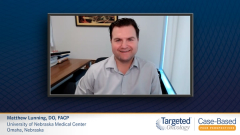
R/R DLBCL: Safety and Efficacy Data from the L-MIND Trial
A review of the methods and data from a clinical trial investigating a combination therapy for relapsed/refractory DLBCL.
Episodes in this series

Case Overview: A 64-Year-Old Man with Diffuse Large B-Cell Lymphoma (DLBCL)
Case History
June 2020: A 64-year-old man presented with DLBCL
Stage III disease
ECOG PS 2
Serum LDH=3.7 x ULN
NCCN-IPI score=6 (High-risk)
History of hypertension (well-controlled)
Patient does not harbor MYC, BCL2, or BCL6 rearrangements
July 2020: Patient began treatment with RCHOP (rituximab, cyclophosphamide, doxorubicin, vincristine, prednisone) induction therapy
Patient had neutropenic fever and limiting fatigue that was controlled with growth factor support; also had mild neuropathy
Underwent interim CT scan after 3 cycles/9 weeks and again at completion of therapy (6 cycles/18 weeks)
Patient achieved a metabolic complete response at 18-week PET-CT scan
May 2021 (6 months post–RCHOP completion): the patient complained of recent weight loss, fatigue
Followup CT scan revealed that the patient had relapsed disease
Patient started salvage chemotherapy with R-GemOx (rituximab, gemcitabine, oxaliplatin)
Most Recent Follow-up Notes/Labs
November 2021: 6-month for-cause CT scan and subsequent biopsy revealed that the patient was refractory to GemOx
The patient lives 50 miles from a healthcare facility that administers CAR T-cell therapy and does not have reliable transportation or continuous caregiver support; he and his clinician decided to start 3rd-line tafasitamab/lenalidomide
April 2022: The patient remains on tafasitamab/lenalidomide; fatigue has mostly resolved
Matthew Lunning, DO, FACP: Tafasitamab-lenalidomide pairs a drug that not many people had used before—tafasitamab, a CD19 monoclonal antibody—with a drug that we’ve used in many areas, in not only non-Hodgkin lymphoma but also multiple myeloma. You have a drug with a lot of name recognition in lenalidomide and a new drug targeting something that probably hadn’t been targeted before in the relapsed/refractory diffuse large [B-cell] lymphoma [DLBCL] space.
Tafasitamab given in IV [intravenous] is front-loaded with multiple intravenous doses during the first couple of cycles. In the study, lenalidomide was dosed at 25 mg and given every 21 days, with an 8-day break. In my experience, lenalidomide at that dose can be difficult for patients to tolerate. However, in this study, the dose intensity is very interesting. About 8 of 10 individuals were able to stay at 20 mg or more of lenalidomide during their treatment course. Obviously, dose reductions occur—mostly with lenalidomide because of cytopenias, in my experience. But if you can find the right dose for that individual, then tafasitamab has some activity by itself.
It appears that when you add tafasitamab to lenalidomide that you increase the potential for efficacy. In relapsed/refractory diffuse large B-cell lymphoma, when you look at the data with tafasitamab, if you aren’t going toward second-line platinum-based therapy to try to get to a transplant, starting tafasitamab-lenalidomide in earlier lines of therapy—potentially even 1 prior line of therapy if you can get those individuals into a complete remission [CR]—is where the curves of the duration of remission in people in a CR has showed a substantially high percentage of people remaining in CR over time. That’s one of the encouraging signs of this drug and regimen. That’s not to mean that if you’re second line or beyond that you don’t have the potential to derive benefit. But that benefit, at least in the curves, are in people who can get into a CR. You can see some people who go from PR [partial response] to CR over time, but it’s important with this drug, as I was alluding to about dose intensity, and getting those doses of tafasitamab in early to gain disease control.
When you introduce lenalidomide at the dose that it was introduced in, one thing I’m very cognizant about with this regimen as they’re starting therapy is their creatinine clearance. In this study, everybody had a creatinine clearance greater than 60 mL/min. Because if you’re borderline or below that, you’d be talking about dose reductions. There could be some tolerance issues. Cytopenias were one of the things that stuck out and may require dose holds or dose reductions with the lenalidomide fatigue. As in this case, fatigue was one of the issues. But then you start to figure out what’s disease-related fatigue vs lenalidomide-related fatigue. You can see diarrhea being one of the issues. Then we’re thinking about infections from that standpoint.
When I look at the AE [adverse event] profile of tafasitamab-lenalidomide, for that first year of therapy, when you’re giving lenalidomide plus tafasitamab, the toxicities are being driven mostly by the lenalidomide. That is foretold because after 1 year in those individuals who are still in response and continue on the tafasitamab given every other week, you see a lot of the cytopenia grading scale back. I see a lot of the fatigue and diarrhea fall off. As far as single-agent tafasitamab in individuals who are doing well, we don’t know because we don’t have randomized studies of stopping after 1 year vs continuing tafasitamab. But I truly feel in relapsed DLBCL when you look at the disease space that the tafasitamab at 1 year and beyond is likely adding to that durability.
Transcript edited for clarity.










































